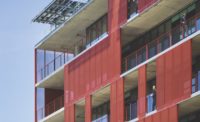Architect Mark Chambers has focused on advancing environmental policy at the city-government level for more than a decade, working in the District of Columbia and in New York. For the latter, he was director of the Mayor’s Office of Sustainability, where he led development and passage of Local Law 97—2019 legislation that set stringent limits on a buildings’ carbon emissions. Earlier this year, he started working on climate issues at the federal level as senior director of building emissions at the White House Council on Environmental Quality. Chambers spoke with RECORD last month about his new role in President Biden’s administration.
What are the responsibilities of the Council on Environmental Quality?
The Council is a convener and serves as a critical checkpoint for the government’s environmental and climate policy. We tie the many moving pieces together and engage with federal agencies and the public at large.
The Council was created in 1969, but you are its first senior director of building emissions. Is that true?
Correct. The position hadn’t existed before. Buildings are where we sleep, go to school, and work. But the energy used to heat and cool and operate them represents nearly a third of our greenhouse-gas emissions. Creation of this new position acknowledges buildings as critical to our climate response. My role is coordinated with the larger environmental effort of the federal government, but also has a sector-specific approach.
New York’s Local Law 97 sets statutory caps on CO₂ emissions. Is it a blueprint for federal policy?
The work that we did in New York was the spear tip of the work necessary to decarbonize the built environment. It also lowered the risk for other cities to be able to do the same thing: if the largest city in the country can do it, they can too.
That thinking also applies at the national level. Setting performance targets is a critical part of galvanizing the industry around a common cause with clear and measurable outcomes. You need to know what you’re tracking toward and be able to look at building operations based on a greenhouse gas assessment to understand if you will achieve the desired outcomes. That is why we are pursuing performance standards for federal buildings. That’s the type of leadership that’s necessary in order to move the industry to decarbonize as quickly as possible.
Can you talk about aspects of President Biden’s American Jobs Plan that tackle both global warming and social injustice?
Forty percent of the climate and clean-infrastructure investments would be directed toward disadvantaged communities. One key aspect of that initiative is aimed at the shortage of affordable housing. Energy costs are a large part of that problem. The plan includes a significant investment to make housing more efficient, improve thermal envelopes, and reduce reliance on fossil fuels, improving the quality of life for many Americans.
If the infrastructure plan ultimately supported by Congress excludes buildings, and there is no subsequent reconciliation package, how will the president achieve his climate goals?
President Biden is working across the aisle and calling on Congress to pass the Bipartisan Infrastructure Plan and build on it with future legislation this year. And he’s encouraged that both the House and the Senate are working on a budget resolution. However, we’re moving full steam ahead right now. There is no waiting for anything. We are moving forward on myriad different efforts with our existing powers and budgets because there’s no time to waste. We’ve released a national road map for making buildings more efficient and grid-interactive and have launched a low-carbon buildings pilot. We are accelerating the development and adoption of heat-pump technologies. And we are investing $30 million in workforce development, particularly related to constructing, retrofitting, and electrifying America’s buildings. There’s no sitting on the sidelines. We are going to keep being aggressive in pushing for the change that is needed—change that the industry is actually asking for.






Post a comment to this article
Report Abusive Comment